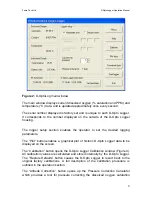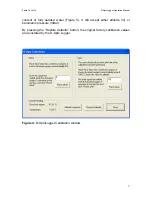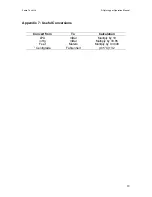
Zebra-Tech Ltd
D-OptoLogger Operation Manual
11
3.5 Calibration
Under normal operating conditions, the D-Opto Logger should only require
infrequent calibration.
Calibration of the D-Opto Logger is a simple operation that can be carried out in
the field. Due to the measurement principle of the D-Opto Logger, performing air
calibrations are not advisable. The Zebra-Tech Do-Cal Kit greatly simplifies the
field calibration of the D-Opto Logger.
The offset and gain of the D-Opto Logger are calibrated individually. Normally
only the offset will need to be calibrated as the gain is even more stable than the
offset over time. The gain should only be calibrated
AFTER
the offset has been
calibrated.
When calibrating the D-Opto Logger, take care not to allow water to enter into the
instrument.
•
Offset
Calibration
A reference solution of 0% dissolved oxygen is required for the offset
calibration. This can be created by mixing a couple of teaspoons of
sodium sulfite into 1 litre of distilled or fresh tap water.
Procedure:
1) Place the D-Opto Logger in the reference solution and allow
equilibrating for at least 30 minutes.
2) Power up the D-Opto Logger, and start D-OptoLog. Once the
measurements have stabilised, press the “Calibrate” button in the main
window.
3) Enter 0 (zero) in the offset calibration edit box and press the “Reset
offset” button.
4) The D-Opto Logger performs a calibration routine followed by a self
check; this can take up to 30 seconds. Do not remove the D-Opto
Logger from the reference solution during this period. The operator will
be notified when the process is complete.
•
Gain
Calibration
A solution of known dissolved oxygen content, other than 0%, should be
used for the gain calibration. The most practical method is to create a fully
aerated solution. This can be done by bubbling air through a container of
distilled or fresh tap water, stirring frequently. After around 30 minutes,
the water can be assumed to be fully saturated.
The actual dissolved oxygen saturation can be calculated by correcting for
altitude, or preferably, the local barometric pressure if that is known. The
“Correction Calculator” can be used to calculate the corrected dissolved
oxygen content of the fully aerated reference solution. As an example, if




















